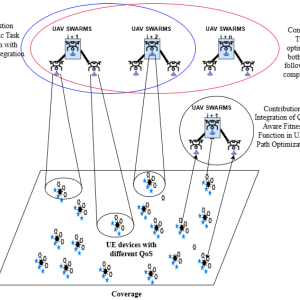The increasing use of unmanned aerial systems (UAS) by both state and non-state actors poses to need for the U.S. Army to seek advanced Counter-UAS. These aerial platforms, ranging from small, commercially available drones to larger, more sophisticated military-grade systems, are being utilized for surveillance, reconnaissance, and offensive operations. The U.S. Army, recognizing the critical need to counter these threats, is actively seeking advanced counter-UAS (C-UAS) solutions, particularly focusing on high-energy laser (HEL) systems. This comprehensive article delves into the specifics of the U.S. Army’s efforts to develop and deploy these cutting-edge technologies, highlighting the strategic importance, technological advancements, and potential operational impacts.

The Strategic Importance of Counter-UAS Technologies
Evolving Threat Landscape
The proliferation of UAS technology has led to a complex threat landscape where adversaries can leverage these systems for various missions. UAS can be used for intelligence gathering, target acquisition, and even direct attacks on military assets. The asymmetric nature of UAS threats means that even relatively unsophisticated adversaries can pose significant challenges to conventional military forces.
Need for Advanced Countermeasures
Traditional kinetic countermeasures, such as anti-aircraft guns and missiles, are often inefficient and cost-prohibitive when used against small, agile drones. The high cost per engagement and the potential for collateral damage make these methods unsuitable for widespread use. Therefore, there is a pressing need for advanced, cost-effective, and scalable solutions capable of neutralizing UAS threats with precision and minimal collateral impact.
High-Energy Laser Systems: The Future of Counter-UAS
Technological Advancements in HEL Systems
High-energy laser systems represent a promising solution to the UAS threat. These systems utilize directed energy to disable or destroy hostile drones. Recent advancements in laser technology have significantly improved the power output, beam quality, and operational reliability of HEL systems, making them viable for military applications.
Advantages of HEL Systems
- Precision Engagement: HEL systems offer unparalleled precision, allowing for the targeted neutralization of UAS with minimal risk to surrounding assets.
- Cost-Effectiveness: Unlike traditional kinetic weapons, which incur significant per-shot costs, HEL systems operate at a fraction of the cost per engagement, primarily limited to electrical power consumption.
- Scalability and Flexibility: HEL systems can be scaled to address a wide range of threats, from small commercial drones to larger military-grade UAS. Additionally, they can be integrated into various platforms, including ground vehicles, naval vessels, and airborne platforms.
- Silent and Stealthy: The silent operation of HEL systems provides a tactical advantage, as engagements can be conducted without revealing the position of the defending forces.
Current U.S. Army Initiatives in Counter-UAS HEL Systems
Development Programs and Partnerships
The U.S. Army is actively engaged in several development programs aimed at enhancing its C-UAS capabilities through HEL systems. Key programs and partnerships include:
- High Energy Laser Mobile Test Truck (HELMTT): This initiative involves integrating a high-energy laser onto a mobile platform to provide flexible and rapid-deployment C-UAS capabilities.
- Indirect Fire Protection Capability-High Energy Laser (IFPC-HEL): Aimed at protecting critical assets from UAS and other aerial threats, this program focuses on developing a high-power laser system capable of neutralizing multiple targets simultaneously.
- Strategic Partnerships: The U.S. Army collaborates with leading defense contractors, research institutions, and allied nations to accelerate the development and deployment of advanced HEL systems.
Testing and Evaluation
Rigorous testing and evaluation are crucial to ensuring the effectiveness and reliability of HEL systems. The U.S. Army conducts extensive field trials and simulations to assess the performance of these systems under various operational conditions. Key focus areas include:
- Target Acquisition and Tracking: Advanced sensor and tracking technologies are integrated with HEL systems to ensure rapid and accurate target acquisition, even in complex environments.
- Environmental Resilience: HEL systems are tested for performance in diverse environmental conditions, including adverse weather and varying atmospheric densities.
- Operational Readiness: The U.S. Army evaluates the ease of deployment, maintenance requirements, and overall readiness of HEL systems to ensure they can be effectively integrated into current and future military operations.
Operational Deployment and Tactical Considerations
Integration into Existing Defense Networks
The successful deployment of HEL systems requires seamless integration into existing defense networks and command-and-control (C2) systems. This ensures that HEL systems can operate in concert with other defensive measures, providing a comprehensive and layered defense against UAS threats. Key integration considerations include:
- Interoperability: HEL systems must be compatible with current radar, sensor, and communication networks to enable coordinated defense efforts.
- Command and Control: Effective C2 integration allows for real-time decision-making and rapid response to emerging threats, ensuring that HEL systems can be employed efficiently in dynamic operational environments.
- Scalability: HEL systems should be scalable to support various mission profiles, from fixed-site defense to mobile and expeditionary operations.
Tactical Employment Strategies
To maximize the effectiveness of HEL systems in counter-UAS operations, the U.S. Army is developing and refining tactical employment strategies. These strategies focus on:
- Layered Defense: Combining HEL systems with other defensive measures, such as electronic warfare (EW) and kinetic interceptors, to create a multi-layered defense that enhances overall effectiveness.
- Distributed Operations: Deploying HEL systems across multiple platforms and locations to provide broad coverage and reduce vulnerability to concentrated attacks.
- Adaptive Engagement: Utilizing advanced algorithms and machine learning to enable HEL systems to adapt to evolving threats and optimize engagement strategies in real-time.
Challenges and Future Directions
Technical and Operational Challenges
Despite significant progress, several technical and operational challenges remain in the development and deployment of HEL systems:
- Power Supply and Management: High-energy lasers require substantial power, necessitating advancements in power generation, storage, and management technologies.
- Thermal Management: Efficient cooling systems are critical to maintaining laser performance and preventing overheating during extended operations.
- Atmospheric Interference: Environmental factors, such as dust, smoke, and humidity, can impact laser beam propagation and effectiveness. Advanced beam control and adaptive optics are being developed to mitigate these effects.
Future Research and Development
Ongoing research and development efforts are focused on addressing these challenges and further enhancing the capabilities of HEL systems. Key areas of future research include:
- Advanced Laser Materials: Developing new laser materials and components to improve efficiency, power output, and operational durability.
- Compact and Lightweight Designs: Reducing the size and weight of HEL systems to enable deployment on a wider range of platforms, including smaller vehicles and unmanned systems.
- Enhanced Targeting and Tracking: Integrating artificial intelligence (AI) and machine learning to improve target recognition, tracking accuracy, and engagement speed.
Conclusion
The U.S. Army’s pursuit of advanced high-energy laser solutions for counter-UAS applications represents a critical step in addressing the evolving threat posed by unmanned aerial systems. By leveraging cutting-edge technology and strategic partnerships, the Army aims to develop and deploy highly effective, cost-efficient, and scalable C-UAS capabilities. The integration of HEL systems into existing defense frameworks, coupled with robust testing and evaluation, will ensure that these advanced technologies can be effectively utilized to protect critical assets and maintain operational superiority. As research and development continue to advance, the future of counter-UAS operations will increasingly rely on the precision, flexibility, and adaptability of high-energy laser systems.











